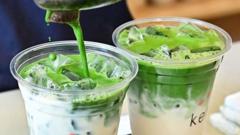Matcha has become a global sensation, with its vivid green hue appearing in an array of products, from Starbucks lattes to Krispy Kreme doughnuts. The phenomenon, triggered by social media influencers sharing brewing techniques, reviews, and recipes, has seen the hashtag "Matcha Tok" garner millions of views. Alongside this, Japan's tourism boom, fueled by a weaker yen, has further amplified interest in Japanese products, including matcha.
The skyrocketing demand has left US-based tea importer Lauren Purvis struggling to keep pace. "What was once a month's supply can deplete in just days," she explained, with some cafes requesting up to a kilo of matcha daily. However, the combination of soaring demand and smaller tea crops due to recent heatwaves and tariffs from the US is causing matcha prices to surge.
Traditionally, matcha is crafted through a meticulous process involving green tea leaves grown in the shade to develop their signature "umami" flavor. Once harvested, these leaves are dried and ground using stone mills, creating a delicate powder. Yet, recent heatwaves have led to poor yields, particularly in the Kyoto region, which produces a significant portion of Japan's matcha.
With the grower population dwindling due to an aging demographic, many shops in matcha hub Uji often sell out soon after opening. To combat shortages, retailers are implementing purchase limits for customers. "With visitor numbers doubling over the past year, demand is skyrocketing," noted Atsuko Mori of Kyoto-based Camellia Tea Ceremony.
Tea master Rie Takeda from Chazen, a tea ceremony chain, has similarly had to adjust to the increasing pressure on matcha stocks, noting that orders, which once arrived promptly, now face delays of more than a week. Consequently, tea prices at Chazen have increased by about 30% this year. Takeda views this demand as a gateway for more global exposure to Japanese culture.
While matcha production has nearly tripled in recent years and green tea exports surged by 25% last year, challenges remain. Advocates for mindful consumption are calling out those who hoard matcha or use high-grade products in cooking, which can diminish its refined flavor. The Global Japanese Tea Association is urging buyers to consider lower-grade matcha for culinary uses.
Furthermore, upcoming tariffs imposed by the US on Japanese goods are poised to further elevate prices. As distributors like Purvis prepare for these impacts, the hope remains for the specialty tea industry to be exempt from such taxes.
Despite current price hikes, some within the industry foresee a potential easing of costs in the coming years as market adjustments occur. Masahiro Nagata, co-founder of Matcha Tokyo, anticipates that while demand is at an all-time high, trends may stabilize in two to three years, making the current boom a temporary spike.





















